
Holnstein Palace [1] [2] [3] (German : Palais Holnstein) is an historic building in Munich, Southern Germany, which has been the residence of the Archbishop of Munich and Freising since 1818.

Holnstein Palace [1] [2] [3] (German : Palais Holnstein) is an historic building in Munich, Southern Germany, which has been the residence of the Archbishop of Munich and Freising since 1818.

The architect François de Cuvilliés built the mansion between 1733 and 1737 for Sophie Caroline von Ingenheim, Countess von Holnstein, a mistress of Charles VII, Holy Roman Emperor. It is today Munich's best rococo style palace as Cuvilliés' less conventional Palais Piosasque de Non was destroyed in World War II. The Holnstein Palace is designed as a four-winged building around a courtyard. The front house was used for representative purposes, while the rear building represented the privacy of the Count. The building is the only noble palace in Munich that kept the original layout. The rococo façade and many interiors have been preserved in their original state.
The façade layout shows three storeys and nine window bays, and a flat central avant-corps with a gable, as often seen in Munich since the time of Joseph Effner. The breakdown of window axes in three fields of three axes also corresponds to the internal division of main and side wings. The upper floors are divided by pilasters. The interior decoration was done by Johann Baptist Zimmermann. Only the elegant façade can be inspected since the palace is closed to the public.
From 1977 to 1982, the Palais Holnstein served as the residence of Archbishop Joseph Cardinal Ratzinger (later Pope Benedict XVI) who stayed here also during his visit in September 2006. The current Munich Archbishop Reinhard Marx lives in three rooms of the palace. Six and a half million Euros of the €8.7 million renovation cost (75%) of the palace were paid by the Free State of Bavaria in 2013.

In European architectural sculpture, an atlas is a support sculpted in the form of a man, which may take the place of a column, a pier or a pilaster. The Roman term for such a sculptural support is telamon.
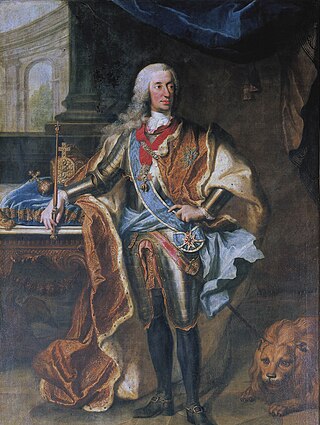
Charles VII was elector of Bavaria from 26 February 1726 and Holy Roman Emperor from 24 January 1742 to his death. He was also King of Bohemia from 1741 to 1743. Charles was a member of the House of Wittelsbach, and his reign as Holy Roman Emperor thus marked the end of three centuries of uninterrupted Habsburg imperial rule, although he was related to the Habsburgs by both blood and marriage.
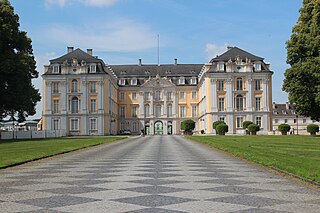
The Augustusburg and Falkenlust Palaces form a historical building complex in Brühl, North Rhine-Westphalia, Germany. The buildings are connected by the spacious gardens and trees of the Schlosspark. Built in the early 18th century, the palaces and adjoining gardens are considered masterpieces of early rococo architecture and have been listed as a UNESCO cultural World Heritage Site since 1984. Augustusburg Palace and its parks also serve as a venue for the Brühl Palace Concerts.

The Nymphenburg Palace is a Baroque palace situated in Munich's western district Neuhausen-Nymphenburg, in Bavaria, southern Germany. The Nymphenburg served as the main summer residence for the former rulers of Bavaria of the House of Wittelsbach. Combined with the adjacent Nymphenburg Palace Park it constitutes one of the premier royal palaces of Europe. Its frontal width of 632 m (2,073 ft) even surpasses Versailles.

The Archdiocese of Munich and Freising is a Latin Church ecclesiastical territory or diocese of the Catholic Church in Bavaria, Germany. It is governed by the Archbishop of Munich and Freising, who administers the see from the co-cathedral in Munich, the Frauenkirche. The other, much older co-cathedral is Freising Cathedral.

The Residenz in central Munich is the former royal palace of the Wittelsbach monarchs of Bavaria. The Residenz is the largest city palace in Germany and is today open to visitors for its architecture, room decorations, and displays from the former royal collections.

The New Palace is a palace situated on the western side of the Sanssouci park in Potsdam, Germany. The building was begun in 1763, after the end of the Seven Years' War, under King Friedrich II and was completed in 1769. It is considered to be the last great Prussian Baroque palace.

The Cuvilliés Theatre or Old Residence Theatre is the former court theatre of the Residenz in Munich, Bavaria, Germany.
François de Cuvilliés, sometimes referred to as the Elder, was a Spanish Netherlands-born Bavarian decorative designer and architect. He was instrumental in bringing the Rococo style to the Wittelsbach court at Munich and to Central Europe in general.
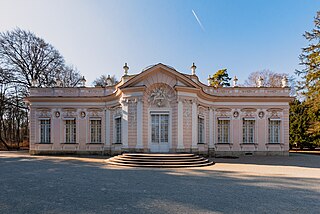
The Amalienburg is an elaborate hunting lodge on the grounds of the Nymphenburg Palace Park, Munich, in southern Germany. It was designed by François de Cuvilliés in Rococo style and constructed between 1734 and 1739 for Elector Karl Albrecht and later Holy Roman Emperor Charles VII and his wife, Maria Amalia of Austria.

The Palais Preysing is a Rococo style building at Residenzstraße 27, opposite the Residenz in Munich, Southern Germany, which served as residence for the Counts of Preysing. To distinguish it from the nearby Palais Neuhaus-Preysing, it is also called the Elder Palais Preysing.

This article gives an overview about the architecture of Munich, Germany.

The Ludwigstraße in Munich is one of the city's four royal avenues next to the Brienner Straße, the Maximilianstraße and the Prinzregentenstraße. The avenue is named after King Ludwig I of Bavaria. The city's grandest boulevard still maintains its architectural uniformity envisioned as a grand street "worthy the kingdom" as requested by the king. The Ludwigstraße has served for state parades and funeral processions.
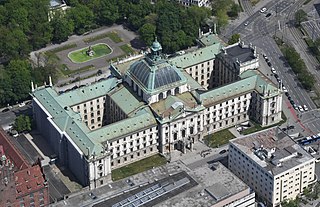
The Justizpalast Munich are two courthouses and administrative buildings in Munich.

The Palais Leuchtenberg, built in the early 19th century for Eugène de Beauharnais, first Duke of Leuchtenberg, is the largest palace in Munich. Located on the west side of the Odeonsplatz, where it forms an ensemble with the Odeon, it currently houses the Bavarian State Ministry of Finance. It was once home to the Leuchtenberg Gallery on the first floor.

The Palais Ludwig Ferdinand is an early 19th-century palace in Munich, Germany, designed by Leo von Klenze. It is located on the Wittelsbacherplatz but forms part of an ensemble with the buildings on the west side of the Odeonsplatz. It was Klenze's own residence, then belonged to Princes Alfons and Ludwig Ferdinand of Bavaria. It is now the headquarters of Siemens.

The following outline is provided as an overview of and topical guide to Munich:

Elizabethan Baroque is a term for the Russian Baroque architectural style, developed during the reign of Elizabeth of Russia between 1741 and 1762. It is also called style Rocaille or Rococo style. The Italian architect Francesco Bartolomeo Rastrelli is the key figure of this trend, which is still given the name 'Rastrellian Baroque'. The Russian architect Savva Chevakinsky is also a renowned figure representing this style.
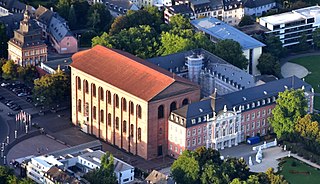
The Electoral Palace in Trier, Germany, was the residence of the Archbishops and Electors of Trier from the 16th century until the late 18th century. It now houses various offices of the federal government and often hosts classical music concerts.

The Kardinal-Faulhaber-Straße is a street in the old town of Munich. It runs from Salvatorplatz in a southwesterly direction to Promenadeplatz.